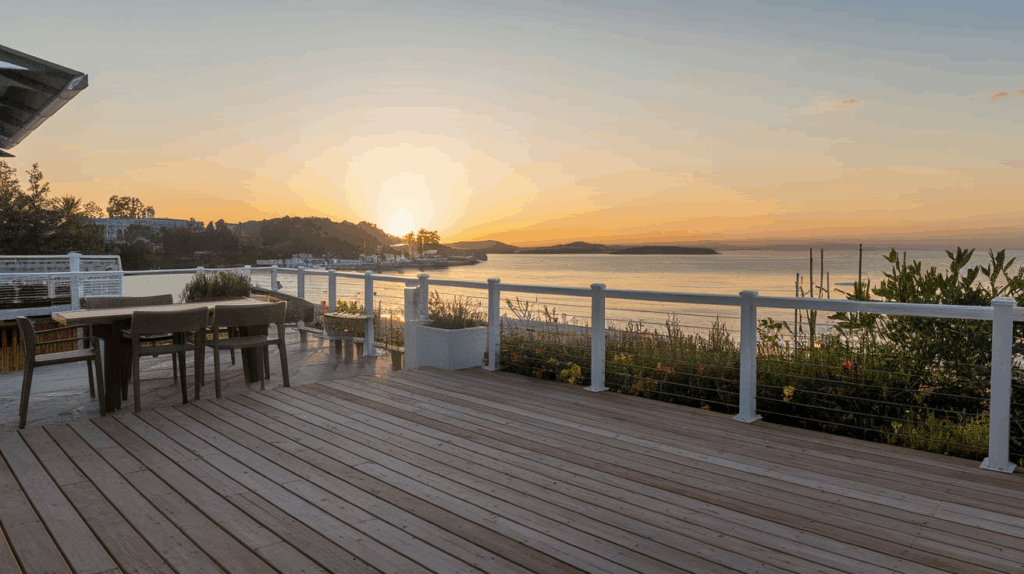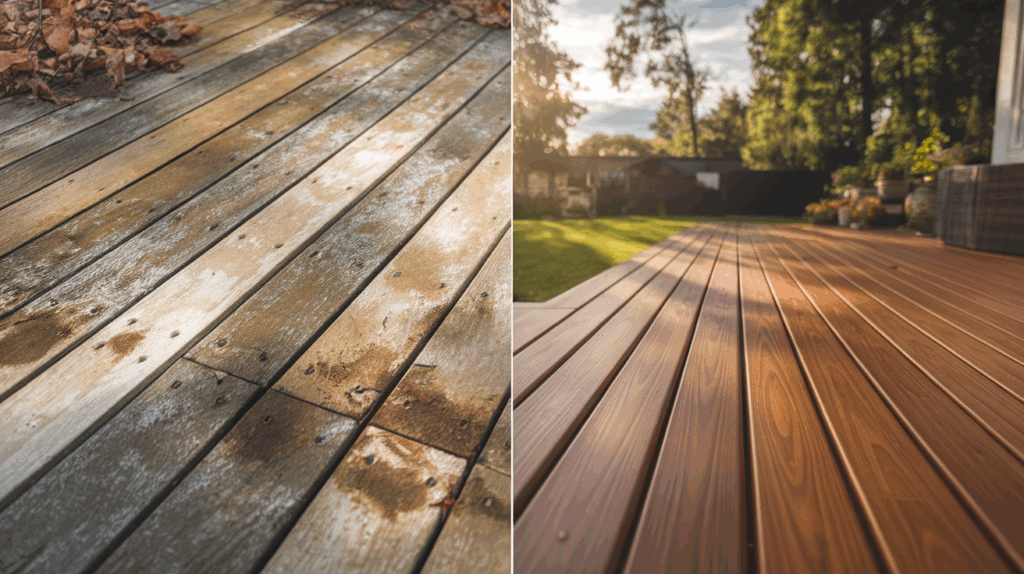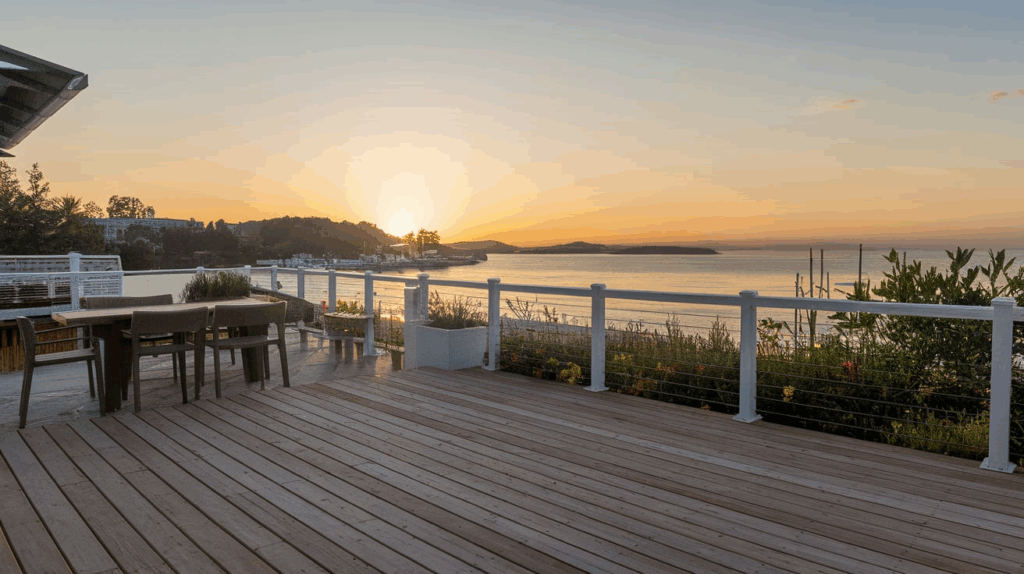Composite decking is a popular choice for homeowners who want a low-maintenance, wood-look outdoor space.
Made from a mix of wood fibers and plastic, it’s designed to handle tough weather, moisture, and daily wear better than traditional wood.
It doesn’t need staining, sealing, or constant upkeep, just simple cleaning now and then.
When building a deck, lifespan matters. You want something that not only looks great but also lasts. Decks face rain, sun, snow, and heavy foot traffic, so choosing a durable material is key.
So, how long does composite decking last? On average, between 25 and 30 years. Some brands even offer warranties up to 50 years.
In this post, I’ll explain what affects its lifespan and what you can do to help it last even longer.
What Is Composite Decking?

Composite decking is an alternative to traditional wood that’s made by combining wood fibers with recycled plastic.
The result is a durable board that looks like wood but resists many of the problems wood faces, like rot, splintering, and insect damage.
There are two main types of composite decking: uncapped and capped. Uncapped boards are the original style and more affordable, but they’re more vulnerable to staining and fading.
Capped boards have a protective outer shell that helps resist moisture, mildew, scratches, and fading, making them a better long-term option.
Most composite decking is designed to mimic the color and grain of real wood, giving your deck a natural appearance without the high maintenance.
It’s ideal for busy homeowners who want a good-looking, long-lasting outdoor space with less effort.
How Long Does Composite Decking Typically Last?
On average, composite decking lasts between 25 and 30 years, with some high-end brands offering warranties of up to 50 years.
This long lifespan is one of the biggest reasons homeowners choose composite over traditional wood.
Most manufacturers back their products with 25–50 year warranties, which gives you a solid idea of how long they expect their decking to hold up.
These warranties usually cover issues like structural damage, splintering, rotting, and excessive fading. Some even offer stain and fade guarantees for capped boards.
The difference between pressure-treated wood and wood decking is clear. With regular maintenance like sealing and staining, pressure-treated wood may last 10 to 15 years.
Hardwood options can last up to 20 years, but they still need lots of care. Composite decking offers a longer life with far less upkeep, making it a smart long-term investment.
Factors That Affect the Lifespan of Composite Decking

Composite decking is known for its long life, but not all decks age the same way. Several factors, like the quality of materials, your local climate, and how the deck is installed or maintained, can impact how long it holds up.
1. Quality of Materials and Brand
Higher-end composite decking uses dense wood fibers, recycled plastics, and durable outer coatings. These materials resist fading, moisture, and wear better than cheaper brands.
Premium products often come with longer warranties and hold up better in real-world conditions, making the brand and quality a major factor in overall lifespan.
If you’re like me and plan on staying at the place for a long time, this is definitely worth it.
2. Climate and Weather Exposure
Harsh climates can shorten a deck’s life. Intense sun may fade colors, while rain and snow increase the risk of mildew. Freezing and thawing can also impact structural components.
Choosing composite boards designed for your specific climate and ensuring proper airflow and drainage during installation will help combat weather-related wear.
3. Installation Method
Proper installation ensures long-term stability and performance. Incorrect joist spacing, poor ventilation, or bad fastening methods can lead to warping or sagging.
Composite decking requires precise spacing to allow for thermal expansion and drainage.
Following manufacturer guidelines or hiring a pro helps avoid issues that could shorten the life of your deck.
4. Maintenance (or Lack of It)
Composite decks are low-maintenance, but not maintenance-free. Neglecting to clean up spills, dirt, or leaves can lead to mold or staining over time.
A simple routine using soap and water keeps the surface in good shape. Avoid harsh chemicals and pressure washers, which can damage the boards and reduce their lifespan.
5. Foot Traffic and Usage Level
Decks used frequently for entertaining, grilling, or high foot traffic will show signs of wear sooner. Heavy furniture, sharp objects, or pets can scratch or scuff the surface.
Using protective pads under furniture and rotating usage areas can reduce wear in one spot and help the deck age more evenly.
Signs Your Composite Decking Is Nearing the End of Its Life
Even well-made composite decking eventually shows signs of aging. Catching these early can help you plan repairs or replacement before safety or appearance becomes a serious issue.
Fading, Staining, or Discoloration
If your deck looks dull, patchy, or permanently stained despite cleaning, it may be breaking down. UV exposure and spilled food or grease can cause deep discoloration.
Warping or Swelling
Composite boards should stay relatively stable, but excessive heat, moisture, or poor installation can cause them to warp or swell.
If boards are rising at the edges, feel spongy underfoot, or no longer sit flush, they may be absorbing moisture or shifting, both signs that the material is wearing out.
Cracks or Surface Separation
While composite decks don’t splinter like wood, deep cracks or visible splits in the surface are signs of aging. These can occur after years of sun exposure, heavy use, or freeze-thaw cycles.
Loss of Structural Integrity
If your deck starts to feel unstable, bounces when walked on, or shows signs of sagging or soft spots, the issue may go beyond surface wear.
Moisture damage, frame rot (in wood substructures), or aging fasteners can cause structural issues that indicate the decking is no longer safe or sound.
How to Extend the Life of Your Composite Deck

Composite decking lasts a long time, but a few simple habits can help you get even more years out of it. These easy care and usage tips will protect the surface, preserve the color, and keep your deck looking and performing its best.
1. Regular Cleaning Tips
Clean your deck every few months using warm, soapy water and a soft-bristle brush or cloth.
This removes dirt, pollen, and debris that can lead to staining or mildew. Rinse thoroughly to avoid buildup.
2. Avoiding Harsh Chemicals or Pressure Washers
Stay away from bleach, acetone, or other strong cleaners, as they can eat away at the protective layer. Likewise, pressure washers can damage the surface if used incorrectly.
Stick with mild cleaners recommended by the manufacturer and always test in a small area first.
3. Protecting from Heavy Furniture or Hot Grills
Place pads under heavy furniture legs to avoid dents or scratches. Keep grills on heat-resistant mats to prevent grease stains or heat damage.
Avoid dragging furniture across the surface. These small steps have helped prevent surface stress and kept my deck looking good for longer.
4. Using Rugs or Mats Designed for Composite Decks
Only use outdoor rugs labeled as safe for composite decking, typically ones made from polypropylene or similar materials.
Avoid rubber-backed rugs, which can trap moisture and stain the surface. Well-placed rugs help protect high-traffic areas without causing damage underneath.
Composite Decking vs. Wood: Which Lasts Longer?
One of the biggest questions when choosing between composite decking and traditional wood is longevity. While wood offers natural beauty, composite decks are built for endurance with far less upkeep.
| Feature | Composite Decking | Wood Decking (Pressure-Treated or Cedar) |
|---|---|---|
| Lifespan | 25–30+ years (up to 50 with care) | 10–20 years depending on upkeep |
| Maintenance | Low – occasional cleaning | High regular sealing, staining, and repairs |
| Initial Cost | Higher upfront | Lower upfront |
| Cost Over Time | Lower – fewer repairs, no staining | Higher, frequent maintenance adds up |
| Fade & Rot Resistance | Excellent, especially capped boards | Poor – prone to rot, mold, and insect damage |
| Appearance Over Time | Holds color better with less fading | Grays or deteriorates without upkeep |
| Warranty | 25–50 years (depending on brand) | Often limited or none |
Long-Term Value and Return on Investment
Composite decking is absolutely worth it for many homeowners, especially those looking for a long-term, low-maintenance outdoor solution.
While it costs more upfront than wood, it pays off in durability, ease of care, and appearance over time.
It doesn’t need staining or sealing, won’t rot or splinter, and resists fading and insect damage, making it ideal for busy households and high-moisture areas.
If you plan to stay in your home for many years, want to spend less time on upkeep, or live in a climate that’s tough on wood, composite decking is a smart investment.
The consistent look, long lifespan, and reduced maintenance add up to real value in the long run.
Conclusion
Composite decking is built to last, making it a smart choice for homeowners who want a low-maintenance, durable outdoor space.
With an average lifespan of 25 to 30 years, and in some cases even longer, composite boards outlast most wood options while avoiding problems like rot, splintering, and termite damage.
If you live in a humid climate, plan to stay in your home long-term, or want a deck that looks good with minimal effort, composite decking delivers real value.
I’ve seen how well it withstands weather, foot traffic, and everyday use while maintaining its appearance for decades.
Thinking about building or upgrading a deck? Reach out to a decking pro, browse composite brands, or start planning your project today.

